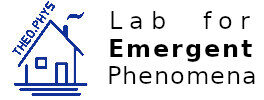Diploma thesis – Michael Klatt
Michael Klatt
Morphometric analysis in gamma ray astronomy
finished 2010-12
supervised by Klaus Mecke
Abstract
H.E.S.S., an array of four imaging atmospheric Cherenkov telescopes for gamma-rays above 100 GeV, observes an increasing number of large extended sources. A new technique based on the morphology of the sky map is developed to account for these additional structures compared to the common point source analysis based on Li and Ma. Minkowski functionals are powerful measures from integral geometry, which comprise all additive scalar geometric information [1]. They can be used to quantify the structure of the count map, which is then compared to the expected structure of a pure Poisson background. Gamma-ray sources lead to significant deviations from the expected background structure. The likelihood ratio method of Li and Ma is exclusively based on the number of excess counts and discards all further structure information of large extended sources. The morphometric data analysis incorporates this additional geometric information in an unbiased analysis, i.e. without the need of any prior knowledge about the source. A concept for the subtraction of known sources within the field of view is developed. The method is successfully applied to data of the H.E.S.S. experiment. The morphometric data analysis presented here is especially efficient in the detection of faint extended sources. [1] G. Schröder-Turk et al., J. of Microscopy, 238(1), 57-74 (2010)
H.E.S.S., an array of four imaging atmospheric Cherenkov telescopes for gamma-rays above 100 GeV, observes an increasing number of large extended sources. A new technique based on the morphology of the sky map is developed to account for these additional structures compared to the common point source analysis based on Li and Ma. Minkowski functionals are powerful measures from integral geometry, which comprise all additive scalar geometric information [1]. They can be used to quantify the structure of the count map, which is then compared to the expected structure of a pure Poisson background. Gamma-ray sources lead to significant deviations from the expected background structure. The likelihood ratio method of Li and Ma is exclusively based on the number of excess counts and discards all further structure information of large extended sources. The morphometric data analysis incorporates this additional geometric information in an unbiased analysis, i.e. without the need of any prior knowledge about the source. A concept for the subtraction of known sources within the field of view is developed. The method is successfully applied to data of the H.E.S.S. experiment. The morphometric data analysis presented here is especially efficient in the detection of faint extended sources. [1] G. Schröder-Turk et al., J. of Microscopy, 238(1), 57-74 (2010)
